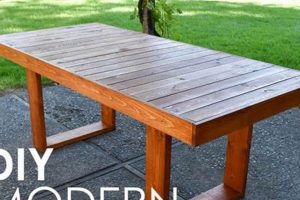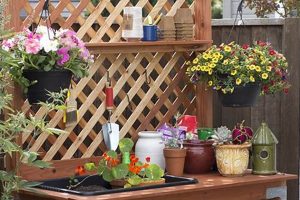The construction of narrow furniture pieces designed to sit flush against the back of a sofa offers a functional solution for limited spaces. These structures, frequently hand-built, provide a surface for various items, such as lamps, books, or beverages, without occupying significant floor area. As an example, one might construct a long, slender surface from reclaimed wood to fit precisely behind a sectional sofa, adding both utility and aesthetic appeal to the living room.
Implementing such a piece enhances spatial efficiency and organizational capabilities within a living environment. The addition can serve as a visual barrier, separating the seating area from other sections of the room. Historically, similar space-saving furniture designs have been employed in urban dwellings and smaller homes to maximize functionality and storage without compromising the available square footage, thereby contributing to a more organized and comfortable living experience.
The following sections will delve into the materials commonly used in fabrication, explore various design considerations, and outline practical steps involved in the construction process. Furthermore, different finishing techniques and customization options will be examined to ensure the final product meets individual needs and complements existing dcor.
Construction and Design Considerations
The following guidelines offer practical advice for successful construction and integration of a narrow console behind seating arrangements.
Tip 1: Measure Accurately: Precision in measurement is paramount. Determine the exact length and height required to ensure the structure aligns seamlessly with the back of the sofa and does not interfere with seating comfort. A slight miscalculation can impact functionality and aesthetics.
Tip 2: Select Appropriate Materials: The choice of material should align with the desired aesthetic and structural requirements. Solid wood offers durability and visual appeal, while plywood provides a cost-effective alternative. Metal framing can introduce a modern industrial design element.
Tip 3: Prioritize Stability: A stable foundation is critical. Employ appropriate joinery techniques, such as mortise and tenon joints or pocket hole screws, to ensure the piece remains rigid and does not wobble. Consider adding support braces for increased stability, especially for longer lengths.
Tip 4: Consider Outlet Accessibility: Integrate power outlets into the design to facilitate convenient charging of devices or powering lamps. Careful planning is necessary to ensure compliance with electrical codes and safe wiring practices.
Tip 5: Apply a Durable Finish: Protect the surface with a durable finish. Polyurethane varnish or lacquer provides resistance to scratches and spills, extending the lifespan of the project. Consider using non-toxic finishes, particularly if small children or pets are present.
Tip 6: Optimize Depth for Functionality: Determine the optimal depth based on intended use. A shallow surface is suitable for decorative items or holding remote controls, while a wider surface allows for placement of larger objects, such as books or lamps. Balance depth with available space behind the sofa.
Tip 7: Ensure Adequate Clearance: Allow sufficient clearance between the top of the sofa and the bottom of the console. This ensures easy access to the back of the sofa for cleaning and prevents abrasion. Maintaining adequate space also contributes to the overall visual appeal of the room.
Adhering to these principles promotes structural integrity, aesthetic coherence, and prolonged usability. Attention to detail during the planning and construction phases ultimately determines the success and longevity of the finished piece.
The subsequent sections will provide a detailed exploration of specific design options, construction techniques, and customization strategies for creating a bespoke solution.
1. Precise dimensional accuracy
The accurate measurement and execution of dimensions are foundational to the successful construction of a narrow console designed for placement behind a sofa. Dimensional precision directly affects the piece’s stability, integration with existing furniture, and overall aesthetic appeal.
- Length Alignment and Spatial Harmony
The length of the structure must precisely match the length of the sofa section it is intended to complement. Discrepancies result in visual asymmetry, creating an unbalanced aesthetic within the room. For example, if the structure is shorter than the sofa, exposed wall space becomes visible, disrupting the visual flow. Conversely, a piece that is too long may obstruct pathways or interfere with adjacent furniture.
- Height Calibration and Accessibility
Height accuracy is crucial for both functionality and comfort. If the console is too low, it may be difficult to reach items placed upon it. Conversely, if it is too high, it may obstruct the view or interfere with the user’s line of sight. Moreover, height precision ensures compatibility with outlets and other wall-mounted features. An example of this is avoiding the obstruction of electrical sockets that are intended for lamps or charging devices on the sofa’s surface.
- Depth Consideration and Space Optimization
The depth of the console should be meticulously calculated to maximize utility without encroaching excessively into the available space. An overly deep structure restricts movement around the seating area, while an insufficient depth limits the practical utility of the surface. For instance, a depth of 6-8 inches might be appropriate for holding small items such as remote controls and beverages, while a greater depth would be required for placing larger objects, such as lamps or decorative items.
- Level Alignment and Structural Integrity
Maintaining level dimensions is critical for structural stability. Uneven legs or a warped surface compromise the integrity of the console, potentially leading to instability or failure. For example, if the legs are not cut to the same length, the structure will wobble, creating an unstable surface. The accurate application of leveling techniques, such as shimming or adjustable feet, is necessary to compensate for minor imperfections and ensure stability.
In conclusion, precise dimensional execution directly affects the structural integrity, functionality, and visual harmony of a console designed for placement behind a sofa. Careful consideration and implementation of accurate measurements are paramount to achieving a successful outcome.
2. Material selection criteria
The selection of appropriate materials is a critical determinant in the successful fabrication of a narrow console intended for placement behind a sofa. Material attributes directly influence structural integrity, aesthetic coherence, and long-term durability. Therefore, a systematic evaluation of available materials is essential to align the final product with its intended use and environment.
- Load-Bearing Capacity and Structural Stability
The selected material must possess adequate load-bearing capacity to support the intended weight without deformation or failure. Solid hardwoods, such as oak or maple, offer superior strength and rigidity, making them suitable for consoles designed to hold heavy objects, such as lamps or books. Engineered wood products, such as plywood or MDF, may be appropriate for lighter loads, provided they are adequately supported. The choice of material significantly impacts the console’s resistance to bending, warping, and overall structural stability.
- Aesthetic Compatibility and Visual Integration
The material’s inherent aesthetic qualities should complement the existing decor of the living space. The color, grain pattern, and texture of the material contribute to the overall visual harmony of the room. For example, reclaimed wood may introduce a rustic charm to a traditional setting, while sleek metal or glass may align with a more contemporary aesthetic. Consideration of these factors ensures that the console seamlessly integrates into the existing environment.
- Durability and Resistance to Environmental Factors
The selected material must exhibit sufficient durability to withstand the rigors of daily use and exposure to environmental factors. Resistance to scratches, moisture, and UV radiation is particularly important for consoles located in high-traffic areas or near windows. Solid wood, when properly sealed and finished, offers excellent resistance to wear and tear. Engineered wood products may require additional surface treatments to enhance their durability and protect against moisture damage. The long-term performance of the console is directly influenced by the material’s ability to withstand these environmental stressors.
- Workability and Fabrication Feasibility
The material’s workability impacts the ease and efficiency of the fabrication process. Solid wood requires specialized tools and techniques for cutting, shaping, and joining. Engineered wood products may be easier to work with, due to their uniform density and predictable behavior. The choice of material should align with the available tools, skills, and time constraints. A material that is difficult to work with may increase the likelihood of errors and prolong the fabrication process.
In summary, material selection is a multifaceted process that involves careful consideration of structural requirements, aesthetic preferences, durability concerns, and fabrication feasibility. A comprehensive evaluation of these factors ensures that the finished console provides both functional utility and aesthetic appeal, seamlessly integrating into the living space for years to come.
3. Structural support framework
The structural support framework represents an indispensable element in the successful construction of a narrow console designed for placement behind a sofa. The absence of a properly engineered framework directly correlates to reduced stability, diminished load-bearing capacity, and a shortened lifespan of the structure. A weak framework introduces the potential for sagging, warping, or even complete collapse under minimal stress. Consider, for instance, a console constructed solely from thin, unsupported plywood; such a structure would likely buckle under the weight of a lamp and a few books, rendering it functionally useless. The importance of the structural framework lies in its role as the foundational skeleton upon which the entire piece is built, providing the necessary resistance to external forces and maintaining the intended form over time.
Effective structural support often involves the strategic placement of internal bracing, the use of robust joinery techniques, and the selection of materials with appropriate strength characteristics. For example, a console built from solid hardwood, incorporating mortise-and-tenon joints at critical stress points, and reinforced with strategically positioned support ribs, would exhibit superior stability and load-bearing capacity compared to a similar structure constructed with weaker materials and less sophisticated joinery. Furthermore, the design of the framework must account for the anticipated weight distribution and potential points of stress concentration. In cases where the console is expected to support heavy objects, additional reinforcement in the form of vertical supports or a thicker tabletop may be necessary to prevent deformation or failure.
In conclusion, the structural support framework is not merely a secondary consideration but rather a primary determinant of the overall quality and longevity of a console designed for placement behind a sofa. A well-engineered framework ensures that the structure remains stable, functional, and aesthetically pleasing for years to come. Overlooking this aspect during the design and construction process inevitably leads to compromised performance and a significantly reduced lifespan. Therefore, careful planning, material selection, and execution of the structural framework are essential for achieving a successful and durable outcome.
4. Integrated power solutions
The integration of power solutions into do-it-yourself (DIY) narrow consoles designed for placement behind sofas constitutes a significant enhancement to their functional utility. This integration addresses the increasing need for convenient access to electrical power within living spaces, particularly for charging mobile devices, powering lamps, and operating other electronic accessories. The absence of integrated power necessitates the use of extension cords and power strips, which can create unsightly clutter and potential safety hazards. Conversely, the inclusion of electrical outlets and USB ports directly into the console provides a streamlined and aesthetically pleasing solution. For example, a DIY console featuring two integrated electrical outlets and two USB charging ports eliminates the need for unsightly power cords trailing across the floor, thereby improving both the appearance and safety of the room.
The process of incorporating power solutions into a DIY console requires careful planning and execution. It is imperative to adhere to all applicable electrical codes and safety regulations to prevent electrical shock or fire hazards. This typically involves using Underwriters Laboratories (UL)-listed electrical components, properly wiring the outlets and USB ports, and ensuring that the console is grounded. For instance, one might utilize a pre-wired power strip with a built-in surge protector, embedding it within the console’s structure and routing the power cord discreetly to a nearby wall outlet. Furthermore, consideration should be given to the placement of the outlets and USB ports to maximize accessibility and minimize visual intrusion. Common placements include the rear of the console’s tabletop or within a recessed compartment.
In conclusion, the integration of power solutions into DIY narrow consoles represents a practical and aesthetically advantageous enhancement. By carefully planning and executing the electrical components, it is possible to create a functional and visually appealing piece of furniture that addresses the modern need for convenient access to electrical power. While this endeavor necessitates adherence to safety regulations and electrical codes, the resulting convenience and aesthetic improvement render it a worthwhile undertaking for DIY enthusiasts seeking to optimize their living spaces.
5. Protective surface finish
The application of a protective surface finish to a DIY console intended for placement behind a sofa represents a critical step in ensuring the structure’s longevity and aesthetic preservation. This finish acts as a barrier, shielding the underlying material from a range of potential damages, including moisture ingress, abrasion, and the deleterious effects of ultraviolet (UV) radiation. Without such protection, the console’s surface is susceptible to staining, scratching, fading, and even structural degradation over time. For instance, a console constructed from unfinished wood and placed near a window would rapidly exhibit signs of fading and discoloration due to prolonged exposure to sunlight. The protective finish, therefore, is not merely an aesthetic enhancement but an essential safeguard against environmental stressors and daily wear and tear.
The selection of an appropriate finish depends on various factors, including the type of material used for the console’s construction, the desired aesthetic outcome, and the level of protection required. Polyurethane varnishes offer excellent durability and resistance to scratches and spills, making them suitable for consoles used in high-traffic areas or those intended to hold frequently used items, such as beverages. Lacquers provide a smooth, durable finish that resists yellowing and is often preferred for lighter-colored woods. Oil-based finishes penetrate the wood, enhancing its natural grain and providing a warm, rich appearance. The application technique is equally important. Proper surface preparation, including sanding and cleaning, ensures optimal adhesion of the finish. Multiple thin coats are generally preferred over a single thick coat, as this minimizes the risk of drips and runs and promotes even coverage. Furthermore, certain finishes require specialized application techniques, such as spraying or wiping, to achieve the desired results.
In conclusion, the protective surface finish is an indispensable component of any DIY console designed for placement behind a sofa. Its proper selection and application not only enhance the aesthetic appeal of the structure but also significantly extend its lifespan by safeguarding against environmental damage and daily wear and tear. The investment of time and resources in selecting and applying an appropriate finish is therefore a critical aspect of the overall construction process, ensuring the long-term viability and value of the DIY project.
Frequently Asked Questions
The following addresses common inquiries regarding the construction and implementation of narrow furniture structures designed for placement behind seating.
Question 1: What are the primary benefits of incorporating a console behind a sofa?
Such additions serve to maximize spatial efficiency, providing a convenient surface for objects while minimizing floor space occupancy. These structures can also delineate zones within open-concept living areas.
Question 2: Which materials are most suitable for constructing a durable and aesthetically pleasing structure?
Solid hardwoods, such as oak or maple, provide superior strength and visual appeal. Engineered wood products, like plywood, represent a cost-effective alternative, provided appropriate support is implemented.
Question 3: How can stability be ensured, particularly for longer console lengths?
Robust joinery techniques, such as mortise and tenon joints or pocket hole screws, are essential. Internal bracing and strategically placed support ribs offer enhanced stability for extended designs.
Question 4: What are the key considerations for integrating electrical outlets into the design?
Compliance with electrical codes and safety regulations is paramount. The use of Underwriters Laboratories (UL)-listed components and proper wiring techniques is mandatory.
Question 5: How does the selection of a surface finish impact the console’s longevity?
A protective finish shields the underlying material from moisture, abrasion, and UV radiation. Polyurethane varnishes and lacquers offer durable and aesthetically pleasing options.
Question 6: What dimensional considerations are most critical to ensure proper fit and function?
Accurate measurement of length, height, and depth is crucial. Discrepancies can lead to instability, aesthetic imbalances, and reduced functionality.
In essence, careful planning, material selection, and adherence to established construction principles are fundamental to the successful creation and integration of a narrow console behind seating.
The subsequent section will provide detailed instructions on the fabrication process, offering step-by-step guidance for crafting a bespoke furniture addition.
Conclusion
The preceding analysis demonstrates the multifaceted nature of designing and constructing a “diy behind the couch table”. Critical aspects, from dimensional accuracy and material selection to structural support, integrated power solutions, and protective surface finishes, demand meticulous consideration. Successful implementation hinges on a comprehensive understanding of these factors and their interdependencies.
Mastery of these elements not only yields a functional furniture piece but also underscores a broader principle: meticulous planning and execution are paramount in any endeavor. The creation of a “diy behind the couch table” serves as a microcosm, reflecting the potential for innovation and efficiency achievable through informed application of knowledge and skill. The pursuit of this project invites further exploration and refinement, solidifying the value of thoughtful design in tangible outcomes.



![Build a Better Miter Saw Table DIY Project [Plans] The DIY Hub: Creative Crafts, Repairs & Life Hacks Build a Better Miter Saw Table DIY Project [Plans] | The DIY Hub: Creative Crafts, Repairs & Life Hacks](https://craftingdiycenter.com/wp-content/uploads/2025/07/th-4266-300x200.jpg)



